
udocker
Part 1 - Introduction
https://github.com/indigo-dc/udocker
Mario David david@lip.pt, Jorge Gomes jorge@lip.pt
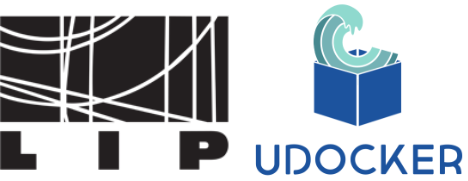

Scientific Computing Challenges I
Running applications across infrastructures often requires considerable effort
- Heterogeneous Hardware:
- Several computing systems
- Laptops, Desktops, Farms, Cloud, HPC
- Multiple OSes and distributions:
- Several operating systems
- Linux flavors, Distribution versions
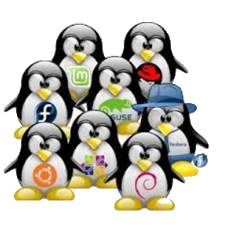
Scientific Computing Challenges II
- Software Environments:
- Specific computing environments.
- Compilers, Libraries, Customizations, Drivers etc.
- Applications:
- Multiple software codes often combined.
- Issues:
- Portability, Maintainability, Reproducibility.

Why using containers for applications I
Encapsulation:
- Applications, dependencies, configurations everything packed together.
- Enables portability across heterogeneous Linux systems.
- Easier distribution and sharing of ready to use software.
Efficiency:
- One single kernel, buffers etc shared by many applications.
- Performance and resource consumption similar to host execution.
- Take advantage of newer more optimized libraries and compilers.
Why using containers for applications II
Reproducibility:
- The whole application and run-time environment is in the container.
- Can be easily stored for later replay, reuse and preservation.
Maintainability:
- Easier application maintenance, distribution and deployment.
- No need to support applications across multiple OS distributions.
- Independance from software changes at the host level.
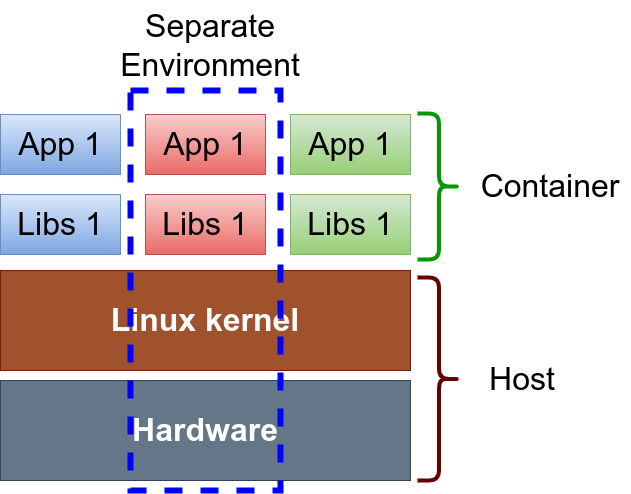
udocker - origin
-
Need for a consistent portable way of running applications.
- Running aplications across different distributions and run-time environments.
-
udocker began to be developed in 2015 in the Indigo-DataCloud project.
- Proof of concept for running docker containers as a regular user.
-
Focused on running scientific applications in Linux systems.
- Batch or Interative, HTC or HPC, across sites in grid infrastrutures.
Containers for batch processing - I
-
Challenges of running containers (docker) on batch systems?
-
Integration with the batch system (how to start/stop containers, etc) ?
-
Respect batch system policies (such as quotas, time and resource limits) ?
-
Respect batch system actions (job management integration delete/kill) ?
-
Collect accounting (tight integration) ?
-
Containers for batch processing - II
- Can we execute in a more simple way?
- Can we download container images?
- Can we run without a layered filesystem?
- Can we run without namespaces?
- can we run without other complex kernel functionalties ?
- Can we run as a regular user without privileges?
- When udocker started to be developed these were major limitations
- Now other tools can also address at least partially these issues
- singularity/apptainer, podman etc
- Yet they depend on kernel functionalities
- that may not be available everywhere
- Now other tools can also address at least partially these issues
udocker: Introduction - I
- udocker can run applications encapsulated in docker containers:
- without using docker
- without requiring (root) privileges
- without system administrators intervention
- without additional system software
- without requiring Linux namespaces
- Everything runs in user space:
- as a regular user without privileges
- subjected to the normal process controls and accounting
- both in interactive or batch systems
udocker: Introduction - II
-
udocker is open source.
-
Developed under the Indigo-Datacloud, DEEP Hybrid-Datacloud, EOSC-Synergy and BigHPC projects.
-
Github repository: https://github.com/indigo-dc/udocker.
-
Documentation: https://indigo-dc.github.io/udocker/.

udocker advantages: deployment I
-
udocker is meant to be deployed and used by the end-user:
-
Does not require privileges.
-
Does not require system administrator intervention.
-
All operations performed in user space.
-
Deployed by default in the user HOME directory.
-
Containers are in the user HOME directory or other user chosen location.
-
udocker advantages: deployment II
- udocker does not require compilation by the user:
- Uses Python plus some binaries.
- Has a minimal dependencies.
- Required binaries are provided statically compiled.
- udocker deployment:
- Just copy and untar into the user home directory.
- Ideal to execute containers across different sites.
- You can deploy udocker across the system where you run.
udocker advantages: execution I
- udocker integrates several execution engines:
- Allows execution using several different approaches.
- Allows execution with and without using Linux namespaces.
- Integrates several tools suitable to execute containers
- Makes these tools easier to use across systems.
- udocker can be submitted together with a batch job:
- Just fetch or ship the udocker tarball with the job.
udocker advantages: execution II
- udocker user interface:
- Commands, syntax and logic are similar to docker.
- udocker empowers users to use containers:
- Ideal for heterogeneous computing environments.
udocker: Command Line Interface
udocker is mainly a run-time to execute docker containers:
| clone | export | help | images | import |
| inspect | install | load | login | logout |
| mkrepo | name | protect | ps | pull |
| rm | rmi | rmname | search | setup |
| showconf | unprotect | verify | version | create |
| run | save |
By design udocker does not have container creation functionality. Containers can be created with other tools.
udocker: How does it work…
Programing languages and OS
- udocker is implemented:
- Python
- the engines and other tools shipped with udocker are binaries:
- C , C++, go
- Can run:
- CentOS 7, RHEL8, RHEL9 (compatible distros)
- Ubuntu >= 16.04
- Any distro that supports python 2.7 and >= 3.6
Components - I
- The udocker Python code (this is what you need to fetch)
- Command line interface
- Dockerhub API
- Container and image handling: import, load, save and export
- Local images repository
- Interface with the execution engines
Components - II
- udocker tools
- Pulled and installed upon first invocation of udocker
- Set of binary executables and libraries that implement the engines
- Supporting different OSes and hardware architectures
- Executables: proot (Pn), runc (Rn), crun (Rn) and patchelf (Fn)
- Libraries: fakechroot (Fn)
udocker in 4 steps - I
Step 1 - Installation:
-
Get the udocker tarball using curl, wget or a browser.
-
Extract the content of the tarball.
-
No need to compile software.
-
The first time udocker is run it will fetch the required binaries.
udocker in 4 steps - II
Step 2 - Get container images:
- Pull containers from docker compatible repositories.
- udocker pull
- Load and save in docker and OCI formats.
- udocker load
- udocker save
- Import and export tarballs.
- udocker import
- udocker export
udocker in 4 steps - III
Step 3 - Create from images:
- Create the container directory tree from the image.
- udocker create
Step 4 - Execute containers:
- Run using several execution methods.
- udocker run
udocker in 4 steps - IV
The steps to fetch and execute containers are important.
- udocker pull IMAGE
- udocker create IMAGE
- udocker run CONTAINER-ID-OR-NAME
- udocker run CONTAINER-ID-OR-NAME
- udocker run CONTAINER-ID-OR-NAME
The created container can be run as many times as you wish.
- You may call
udocker rundirectly but this will create a new CONTAINER everytime - Will be slow and occupy much more space
udocker is an integration tool
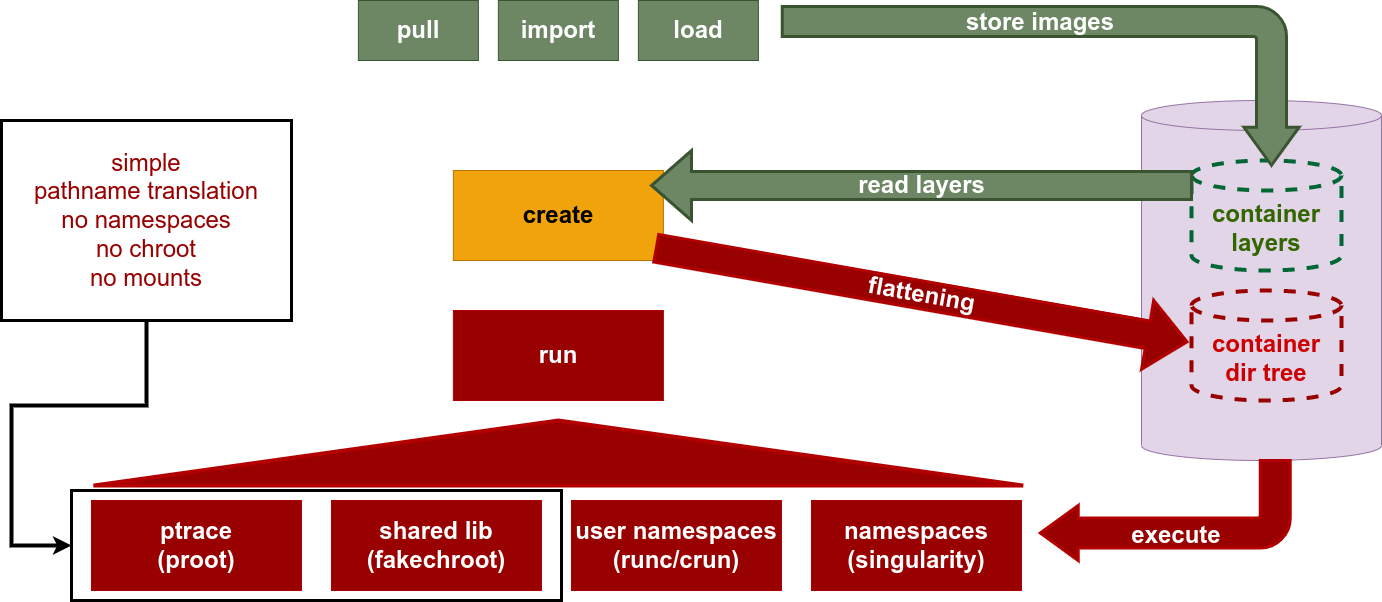
udocker: pull - Images I
- Docker images are composed of:
- metadata describing the images content and how to run
- multiple file-system layers stored as tarballs
- udocker pulls the metadata and layers:
- using the DockerHub REST API.
- Image metadata is parsed to identify the layers.
- Layers are stored in the user home directory under
${UDOCKER_DIR}/.udocker/layers - Image information with links to the layers is under
${UDOCKER_DIR}/.udocker/repos
udocker: pull - Images II

udocker: Create containers - I
- Containers are produced from the images in a process called flattening.
- Each image layer is extracted on top of the previous.
- UnionFS Whiteouts are applied before each layer extraction.
- Protection changes are applied to make files accessible.
- The resulting directory tree is stored under
${UDOCKER_DIR}/.udocker/containers
- Accessing files is easy
- just cd into
${UDOCKER_DIR}/.udocker/containers/CONTAINER-ID/ROOT
- just cd into
- The create can be slow depending on underlying filesystem (e.g. Lustre, GPFS)
- Alternative use the /tmp or some partition local to the host
udocker: Create containers - II

udocker: Run container

udocker: Execution engines I
-
Like in other container tools execution is achieved by providing
chrootlike functionality. -
udocker supports several techniques to achieve the equivalent to a chroot without using privileges.
-
These techniques can be selected per container via execution modes implemented by execution engines.
udocker: Execution engines II
| Mode | Base | Description |
|---|---|---|
| P1 | PRoot | PTRACE accelerated (with SECCOMP filtering): DEFAULT |
| P2 | PRoot | PTRACE non-accelerated (without SECCOMP filtering) |
| R1 | runC | rootless unprivileged using user namespaces |
| R2 | runC | rootless unprivileged using user namespaces + P1 |
| R3 | runC | rootless unprivileged using user namespaces + P2 |
| F1 | Fakechroot | with loader as argument and LD_LIBRARY_PATH |
| F2 | Fakechroot | with modified loader, loader as argument and LD_LIBRARY_PATH |
| F3 | Fakechroot | modified loader and ELF headers of binaries + libs changed |
| F4 | Fakechroot | modified loader and ELF headers dynamically changed |
| S1 | Singularity | where locally installed using chroot or user namespaces |
Selection in terms of performance
| Mode | Base | Description |
|---|---|---|
| P1 | PRoot | System call intensive applications may suffer degradation |
| P2 | PRoot | Same limitations as P1 apply. All system calls are traced causing higher overheads than P1 |
| R1 | runC | Same performance as namespace based applications |
| R2 | runC | Only for software installation and similar. Same performance as P1 |
| R3 | runC | Only for software installation and similar. Same performance as P2 |
| F1 | Fakechroot | All Fn modes have similar performance during execution. Frequently the Fn modes are the fastest |
| F2 | Fakechroot | Same as F1 |
| F3 | Fakechroot | Same as F1. Setup can be very slow |
| F4 | Fakechroot | Same as F1. Setup can be very slow |
| S1 | Singularity | Similar to Rn |
Selection in terms of interoperability I
| Mode | Base | Description |
|---|---|---|
| P1 | PRoot | PTRACE + SECCOMP requires kernel >= 3.5. Can fall back to P2 if SECCOMP is unavailable |
| P2 | PRoot | Runs across a wide range of kernels even old ones. Can run with kernels and libraries that would fail with kernel too old |
| R1 | runC | User namespace limitations apply |
| R2 | runC | User namespace limitations apply. Same limitations as P1 also apply, this is a nested mode P1 over R |
| R3 | runC | User namespace limitations apply. Same limitations as P2 also apply, this is a nested mode P2 over R |
Selection in terms of interoperability II
| Mode | Base | Description |
|---|---|---|
| F1 | Fakechroot | May escape and load host libraries. Requires shared library compiled against same libc as in container |
| F2 | Fakechroot | Same as F1 |
| F3 | Fakechroot | Requires shared library compiled against same libc as in container. Binary executables and libraries get tied to the user HOME pathname |
| F4 | Fakechroot | Same as F3. Executables and libraries can be compiled or added dynamically |
| S1 | Singularity | Not part of udocker must already exist on the system, may use user namespaces or chroot |
udocker: Running applications …
udocker & Lattice QCD
OpenQCD is a very advanced code to run lattice simulations
Scaling performance as a function of the cores for the computation of application of the Dirac operator to a spinor field.
Using OpenMPI, udocker in P1 mode

udocker & udocker & Molecular dynamics
Gromacs is widely used both in biochemical and non-biochemical systems.
In this comparison Gromacs was run using CUDA and OpenMP
- udocker using P mode has lower performance with Gromacs
- udocker using F mode has same or better performance as Docker.
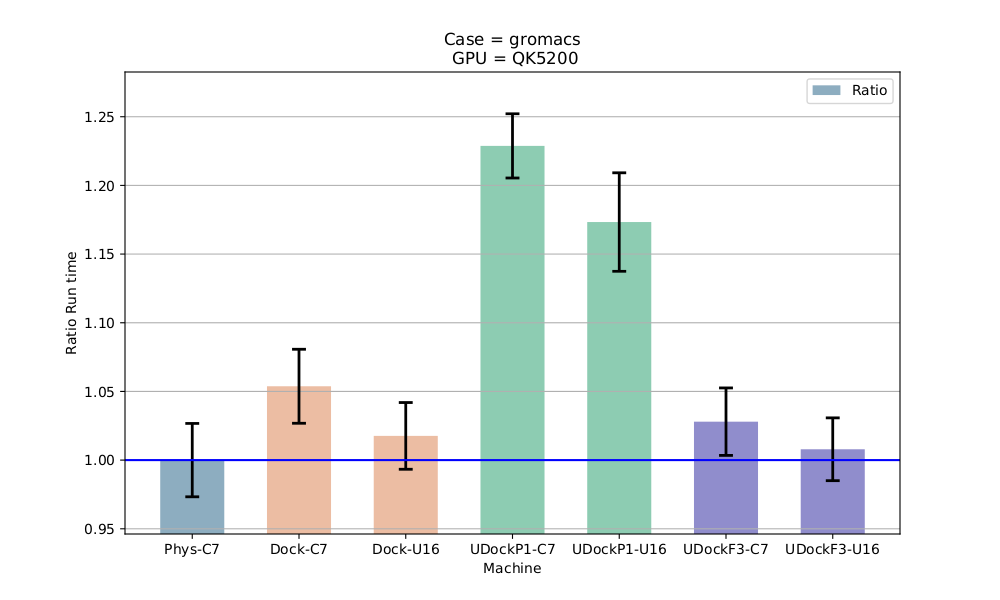
udocker & Phenomenology
MasterCode connects several complex codes. Hard to deploy. Scanning through large parameter spaces. High Throughput Computing.
C++, Fortran, many authors, legacy code. Performance Degradation (udocker in P1 mode)
| Environment | Compiling | Running |
|---|---|---|
| HOST | 0% | 0% |
| DOCKER | 10% | 1.0% |
| udocker | 7% | 1.3% |
| VirtualBox | 15% | 1.6% |
| KVM | 5% | 2.6% |
Thank you!
Questions ?


Backup slides
Other container technologies
-
Singularity (LBL) - udocker currently supports it as execution mode
-
Charliecloud (LANL) - devels contacted Jorge: can udocker have a mode for it? “Merge” the udocker, CLI functionality with underlying Charliecloud engine?
-
Shifter (NERSC) - at the moment no plans on any type of usage/integration in udocker.
-
Podman (RedHat)